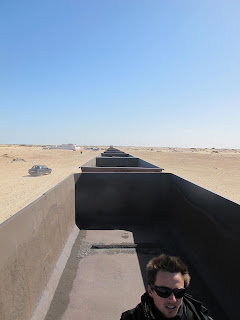Mauritania has been stressful. More tourists have been
kidnapped here in the last five years than anywhere else in the Sahel region.
Both the Frenchies and the Poms have got almost the entire country in their
‘red-zones’ meaning ‘go there and not only will you end up in an orange
jumpsuit but your travel insurance is off the hook’. The country is an Islamic
state which means that public lashes in the town square are still on the cards
if I were to utter a religious comment in bad taste or fire off some untimely
gas. And on the back of this, almost everyone here wears turbans that they wrap
around their faces so that only their eyes peer out. The only images of these
types I’ve seen have been in their own home videos and have generally had a
translator relaying a list of demands that basically require the West go and
fornicate with itself. So throw whole bakkie loads of these guys together,
driving around the streets of most towns and it’s enough to get my frail white
nerves playing like a Tuaregs banjo.
And yet my experiences with the people here could not have
been more different. The gendarmes that diligently man the roadblocks that coat
every road, pathway and camel track, are always friendly and keen to find out
if we have a good time in Mauritania. When strangers come up for a talk in the
street, I keep waiting for the inevitable “Ah my friend, now you come look in
my shop. No for buying. Just for
looking. Looking is for free. You have a nice beard”, but it never comes. When
I ask for the price of things, I’m actually given the real price and not one
that requires thirty minutes of haggling to drag down to a level that doesn’t
require me to pimp out Tough Guy for a night to pay for it. The women – far from being the brow-beaten
stereotypes – are completely insane. The lumo-coloured, tie-dyed shawls they wear a clear indication that they
intend to make up for the lost years of fashion in the 70’s, 80’s and 90’s and
combine them all into one cataractic combo. Bra’s will be burned. And to match
their plucky outfits they pack a tenacity that is, at times admirable and at
others just exhausting. But never dull. And always combined with tea.
So it is with an odd mix of relief and sadness that I leave
these sandy shores. This place has at least been an extremely pleasant
surprise. The landscapes of the Sahara (that dominates ninety percent of the
country’s landmass) are as surprisingly varied and colourful as the people within
them. While I’ve definitely had to examine my own prejudices while I’ve been
here, I still haven’t quite been able to rid myself of that sinking feeling in
my stomach every time a car load of turban-shrouded men has come hurtling in my
direction. And this is a feeling I will not miss.




























.JPG)








.JPG)











